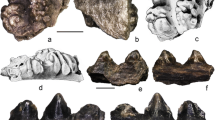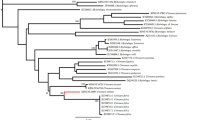Abstract
Redigobius fotuno sp. nov., described from a limestone sinkhole on Muna Island, Southeastern Sulawesi, Indonesia, is most similar to Redigobius penango (Popta 1922), endemic to the Sulawesi mainland, both species having a robust body and rounded head, reticular body color pattern, and longitudinal suborbital papillae rows. However, the new species is distinguished from the latter in having greater head length (35.3–38.4% of standard length [SL]), upper jaw length (14.7–20.0% of SL) and predorsal length (43.4–46.0% of SL), and a slender pelvic disc with thin frenum (length: 21.7–26.2% of SL; base width: 4.2–6.3% of SL). These unique morphological characters of R. fotuno sp. nov. may be related to the limnetic habitat of the species.










Similar content being viewed by others
References
Ahnelt H, Bohacek V (2004) The lateral line system of two sympatric eastern Pacific gobiid fishes of the genus Lythrypnus (Teleostei: Gobiidae). Bull Mar Sci 74:31–51
Akihito Prince (1986) Some morphological characters considered to be important in gobiid phylogeny. In: Uyeno T, Arai R, Taniuchi T, Matsuura K (eds) Indo-Pacific fish biology. Proceedings Second International Conference on Indo-Pacific Fishes. Ichthyological Society of Japan, Tokyo, pp 629–639
Herre AWCT (1927) Gobies of the Philippines and the China Sea. The Philippine Bureau of Science, Monographic publications on fishes. Publication no. 23. Bureau of Printing, Manila
Larson HK (2001) A revision of the gobiid fish genus Mugilogobius (Teleostei: Gobioidei), and its systematic placement. Rec West Aust Mus Suppl 62:1–233
Larson HK (2010) A review of the gobiid fish genus Redigobius (Teleostei: Gobionellinae), with descriptions of two new species. Ichthyol Explor Freshw 21:123–191
Masuda H, Amaoka K, Araga C, Uyeno T, Yoshino T (1984) The fishes of the Japanese Archipelago. Tokai University Press, Tokyo
Nakabo T (2002) Fishes of Japan with pictorial keys to the species, English edition. Tokai University Press, Tokyo
Nakae M, Asaoka R, Wada H, Sasaki K (2012) Fluorescent dye staining of neuromasts in live fishes: an aid to systematic studies. Ichthyol Res 59:286–290
Parenti LR, Hadiaty RK (2010) A new remarkably colorful, small ricefish of the genus Oryzias (Beloniformes, Adrianichthyidae) from Sulawesi, Indonesia. Copeia 2010:268–273
Popta CML (1912) Fortsetzung der Beschreibung von neuen Fischarten der Sunda-Expedition. Notes Leyden Mus 34:185–193
Popta CML (1922) Vierte und letzte Fortsetzung der Beschreibug von neuen Fischarten der Sunda-Expedition. Zool Meded 7:27–39
Sabaj MH (2022) Codes for Natural History Collections in Ichthyology and Herpetology (online supplement). Version 9.0 (14 February 2022). https://asih.org/standard-symbolic-codes. Accessed 16 December 2022
Wongrat P, Miller PJ (1991) The innervation of head neuromast rows in eleotridine gobies (Teleostei: Gobioidei). J Zool 225:27–42
Acknowledgments
We are grateful to Ixchel F. Mandagi (Sam Ratulangi University), Andy B. Nofrianto (Halu Oleo Univ.), Rieko Tanaka (Nagoya Zoo), Ryo Kakioka (Ryukyu Univ.) and Satoshi Ansai (Kyoto Univ.) for kindly assisting our field survey; Helen K. Larson (Museum of Tropical Queensland) for providing information pertaining to the original data from her previous research; and Susanne Dorow, Moritz Sonnewald, Friedhelm Krupp and Renate Rabenstein (SMF), Ilham V. Utama (MZB), and Masanori Nakae and Gento Shinohara (NSMT) for assisting our examination of museum specimens. We also thank Graham S. Hardy (Ngunguru, New Zealand) for revising a draft of the manuscript. We are grateful the Ministry of Research, Technology, and Higher Education, Republic of Indonesia (RISTEKDIKTI) and the Faculty of Fisheries and Marine Science, Sam Ratulangi University, for permission to conduct research in Sulawesi (research permit numbers 107/SIP/FRP/E5/Dit.KI/IV/2018 and 3B/TKPIPA/E5/Dit.KI/III/2019). All experiments were approved by the Animal Care Committee of the University of the Ryukyus (201899). This study was supported by JSPS KAKENHI to HK (19J22686) and KY (17H01675).
Author information
Authors and Affiliations
Corresponding author
Ethics declarations
Conflicts of interest
The authors declare no conflicts of interest.
Ethics approval
The specimens used in this study were appropriately treated in accordance with Regulations of the Animal Care Committee, University of the Ryukyus (permit number 201899).
Additional information
Publisher's Note
Springer Nature remains neutral with regard to jurisdictional claims in published maps and institutional affiliations.
This article was registered in the Official Register of Zoological Nomenclature (ZooBank) as 4DF09761-98A0-439F-80A4-CE8AABAC20B1.
This article was published as an Online First article on the online publication date shown on this page. The article should be cited by using the doi number.
About this article
Cite this article
Kobayashi, H., Sumarto, B.K.A., Mokodongan, D.F. et al. Redigobius fotuno, a new limnetic goby from Muna Island, Indonesia (Teleostei: Gobiidae). Ichthyol Res (2024). https://doi.org/10.1007/s10228-024-00958-0
Received:
Revised:
Accepted:
Published:
DOI: https://doi.org/10.1007/s10228-024-00958-0




